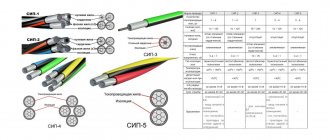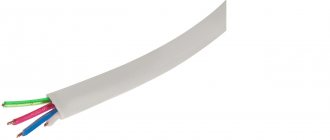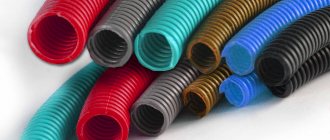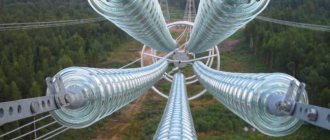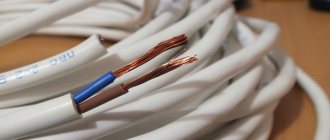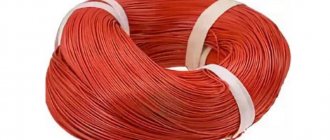SIP wire stands for self-supporting insulated wire. This type of wiring was developed in the 60s in Finland. The main area of application is the creation of main power lines, branches from main power lines, arrangement of connections to buildings and transformer booths.
Various modifications of SIP can be used for lighting if the composition contains lighting wires.
SIP cable comes in several types: SIP-1, SIP-2, SIP-3, etc. Each variety has special technical characteristics and scope of application.
Main area of use
SIP wires are used for the following purposes:
- creation of branches from the main power line;
- laying lighting lines;
- connecting power lines to the transformer box;
- connection of country houses, industrial and public facilities, residential buildings;
- laying wiring along the walls of buildings.
The conditions for using the wire depend on the specific marking. SIP with additional sealing can be used in conditions of high humidity, including in tropical areas, near large artificial or natural reservoirs and bays.
Products with an insulated neutral wire are suitable for use in environments with high salt content, i.e. in coastal cities, near salt marshes or the ocean coast.
Insulated wires have almost completely replaced their predecessor. SIPs are widely used in developed countries, tropical countries, and northern regions.
Important! Wiring on average can withstand temperature changes from -20 to +70 degrees, so it is suitable for use in a wide variety of weather and climatic conditions.
Advantages of SIP brand wires
Well, now about the most important thing - why do self-supporting insulated self-supporting insulated wires deserve such widespread use recently?
And the answer to this question consists of a number of advantages:
- Let's start the list with the most interesting thing - reducing losses. The fact is that the inductive reactance of an overhead line made with SIP wire in comparison with a line made with wire A or AC is three or even more times lower. In essence, it is almost the same as a cable line. And the higher the operating voltage class, the more noticeable this difference is.
- The next important aspect is to reduce the likelihood of short circuits on such a line. This is due to the presence of insulation, as well as the lack of opportunity for wires to overlap, which is a common cause of short circuits in overhead lines with AC wires.
The costs of clearing the air routes of lines are reduced.
The instructions also note a reduction in the cost of maintaining the line, associated with significantly lower costs of clearing the route from green spaces. This question is also relevant when installing new routes.
Up to a dozen different lines can be mounted on one pole using SIP wire.
Another significant aspect is that it is now possible to mount wires of different voltage classes on one pole. And there can be not one or two such lines on one pillar, but a dozen.
Set of fittings for installation of SIP wire
Polyethylene has no polarity. In this regard, snow accumulates on such a wire much less, and water flows off the wire much better. This reduces the likelihood of snow and critical ice build-up on the wires.
Easy to install line with Sip wire
An important aspect is that even a person without special education can install such an overhead line with his own hands. After all, the presence of special fittings allows you to assemble a line with a minimum set of tools and devices.
The connection of new electrical energy consumers is greatly simplified. After all, a new connection can be made even without removing the voltage from the line. For this purpose, there is a special fitting that pierces the insulation and ensures reliable contact.
Fittings for a new connection
The problem of unauthorized connection is also solved by a self-supporting insulated wire - the SIP wire has insulation, which complicates the implementation of throws and hidden connections, because this requires either the use of special fittings or cutting of the insulation, and this is clearly visible even during a visual inspection.
Connecting lighting from an auxiliary SIP wire
Well, another advantage of SIP wire is the presence of auxiliary cores. Such conductors allow you to organize power from a given line of the lighting network. In addition, there are auxiliary conductors for connecting control circuits, which can be used for telesignaling or relay protection.
Self-supporting insulated wire design
SIP wires, as is clear from the name, have an insulating layer. Depending on the type of product, the entire cable may be insulated or only some of its cores. It should be noted that the SIP consists of several parts:
· neutral wire with a steel core and aluminum coating, which acts as a load-bearing wire and strengthens the entire structure;
· from 1 to 3 phase conductors made of aluminum or aluminum alloy, which entangle the carrier in a spiral.
Additionally, an insulating layer of PET or cross-linked PET is applied. The latter has higher thermal stability. The coating must not fade under the influence of ultraviolet radiation, since markings are printed on its surface.
There are varieties of cable without a core. They are less resistant to mechanical loads, such as hail, snow layers, heavy rainfall, and therefore are not used in northern regions. On the other hand, they are more flexible. More details about the design features of various types of SIPs are described below.
Specifications
When choosing a specific brand of SIP wire, it is important to pay attention to the compliance of the characteristics and parameters with the individual requirements of the consumer and the installation method.
To do this, the following technical characteristics are taken into account:
- Number of cores - as a rule, models with the number of current-carrying elements from 1 to 4 are used;
- Cross-section – for different SIP models, this parameter varies from 16 to 240 mm²;
- Voltage class - there are two categories in total - up to 1 kV (SIP-1, 2, 4, 5) and up to 35 kV (SIP-3);
- Temperature regime - implies a normal operating temperature at which the wire will transmit electricity for a long time without losing its parameters;
- Permissible short-term heating - can occur in emergency modes, but should not exceed more than 8 hours of the annual load;
- Bending radius - determines the ability to bend the wire without compromising the mechanical strength of the insulation and its dielectric properties.
All technical characteristics compared for all brands are shown in the table below:
Table comparing characteristics of SIP brands
| Wire brand | SIP-1 | SIP-2 | SIP-3 | SIP-4 | SIP-5 |
| Number of current-carrying cores, pcs. | 1 ÷ 4 | 1 ÷ 4 | 1 | 2 — 4 | 2 — 4 |
| Core cross-section, mm2 | 16 ÷ 120 | 16 ÷ 120 | 35 ÷ 240 | 16 ÷ 120 | 16 ÷ 120 |
| Zero core, bearing | aluminum alloy (with steel cores) | aluminum alloy (with steel cores) | absent | absent | absent |
| Current-carrying core | aluminum | aluminum | aluminum alloy (with steel cores) | aluminum | aluminum |
| Voltage class, kV | 0.4 ÷ 1 | 0.4 ÷ 1 | 10 ÷ 35 | 0.4 ÷ 1 | 0.4 ÷ 1 |
| Core insulation type | thermoplastic polyethylene | light stabilized polyethylene | light stabilized polyethylene | thermoplastic polyethylene | light stabilized polyethylene |
| Operating temperature | -60оС ÷ +50оС | -60оС ÷ +50оС | -60оС ÷ +50оС | -60оС ÷ +50оС | -60оС ÷ +50оС |
| Permissible heating of cores during operation | +70оС | +90оС | +70оС | +90оС | +90оС |
| min wire bending radius | not less than 10 Ø | not less than 10 Ø | not less than 10 Ø | not less than 10 Ø | not less than 10 Ø |
| Life time | at least 40 years | at least 40 years | at least 40 years | at least 40 years | at least 40 years |
| Application | branches from overhead lines; — power supply to living quarters; - household construction laying along the walls of buildings and structures. | branches from overhead lines; — power supply to living quarters; - household construction laying along the walls of buildings and structures. | for installation of overhead lines with voltage 6-35 kV | branches from overhead lines; — power supply to living quarters; - household the buildings; — laying along the walls of buildings and structures. | branches from overhead lines; — power supply to living quarters; - household the buildings; — laying along the walls of buildings and structures. |
Advantages and disadvantages of SIP
Self-supporting insulated wires are widely used in various fields. Their demand is explained by the following advantages:
- The presence of insulation allows you to protect the conductor from interference from external voltage, making it safer and suitable for laying overhead power lines.
- Cables with additional lighting wires can be multifunctional.
- Wide possibilities of operation in different temperature conditions.
- The service life is more than 40 years, the duration of the factory warranty is from 3 to 5 years.
- Low cost of maintenance. Durable cables require virtually no repairs and will not break if installed correctly.
- Low requirements for the size of the support, as well as for the width of the power line. Thanks to this, the size of the power line is reduced, and SIP can be installed even in cities with dense buildings, where it is not possible to use more bulky variations.
- Energy saving. There are practically no losses during transmission from the power plant to the cable and then to the consumer.
- Difficulty of unauthorized access to the cable. The likelihood of illegal connection to power lines is reduced.
Despite a number of positive characteristics, it cannot be said that SIP has no disadvantages. This type of cable is more expensive when purchased, although economical operation can compensate for this disadvantage in the future.
The weight of the cable is much higher than that of analogues, therefore, in order to maintain power lines in a stable condition, it is necessary to install support poles more often.
Installation of SIP lines
When installing SIP wire, you do not need to use traditional ceramic insulators, securing it directly to the pole using hooks and guy ropes. However, the weight of one SIP wire is equal to the total weight of all power line conductors. Therefore, when pulling it, special devices are used.
For example, removable rollers mounted on temporary brackets. It is worth noting that laying such lines requires a greater number of special devices and equipment than when working with conventional “bare” wires. Despite the savings with support poles, the cost of the work is 10-15 percent higher than when laying electrical lines in the usual way. But it pays off in subsequent use.
The use of SIP wires is gradually becoming more widespread, because they really significantly reduce the cost of operating electrical networks, while increasing the overall level of safety.
Types of SIP wires
SIP wires have 6 subtypes. They differ in weight, rated voltage, design features and areas of application.
SIP-1
Wires of the SIP-1 type consist of a load-bearing neutral conductor, which is an aluminum wire with a steel core, and 1-3 phase conductors made of aluminum.
Only the phase conductors are insulated using PET, the neutral conductor remains uncoated.
The temperature conditions that the product can withstand are from -20 to +50-60 degrees.
The wiring can heat up to +90 degrees during operation.
Important! There is a variation of SIP-1A with an insulated neutral wire.
SIP-1 is used to create 2nd and 3rd class connections leading to residential private houses.
Can be used in summer cottages provided that a three-phase power supply is used.
SIP-2
SIP-2 wires differ from the first type in the composition of the insulating sheath. Cross-linked PET is used as a coating. It is more stable when heated, so SIP-2 can operate for a long time when heated to +70 degrees, and for some time at +90.
There is SIP-2 with an insulated neutral wire or non-insulated. The more popular isolated version, SIP-2A. It allows the cable to be used in environments with high salt content, for example, near the ocean.
This type of wiring is used to connect apartment and private buildings, industrial enterprises.
SIP-3
The insulating layer is thicker, and the wire itself is single-core, fixed to a steel core.
Withstands rated voltage 20-35 W. The braid of the supporting wire is made of aluminum alloy.
The wire sheath is cross-linked PET.
Used in the construction of high-voltage lines.
SIP-4
The most popular type of cable is SIP. It lacks a supporting core, which makes the wire lighter and more flexible, but at the same time vulnerable to mechanical stress.
Important! SIP-4 cannot be used in areas where heavy snowfalls and icing of power lines are possible.
SIP-4 has subtypes:
1. SIPn-4. Resistant to fire.
2. SIPgsn-4. Covered with non-flammable PET, the cable contains light wires.
3. SIPsn-4. Non-flammable PET, hermetic insulation protects against moisture.
SIP-5
It differs from SIP-4 in the type of insulation: cross-linked PET is used, which allows increasing the period of exposure to maximum permissible temperatures by 30%. The product is used as part of power lines up to 2.5 kW. May include lighting wires.
SIP-7
Cable with the highest rated voltage (up to 110 kW). Features a three-layer insulation system. The first layer is cross-linked polyethylene, the second is electrically conductive, the third is resistant to precipitation and mechanical stress.
Comparison of different brands in the table
Application area
Self-supporting insulated wires (SIP) are intended for use in overhead power lines (power lines) suspended on supports or facades of buildings and structures.
Climatic modification - UHL, placement categories - 1, 2 and 3, in atmospheres of type II and III according to GOST 15150-69.
As a result of generalizing domestic experience in the construction and operation in a number of regions of the country of overhead power lines with a voltage of 0.38 kV with self-supporting insulated wires, the technical and economic advantages of these lines were revealed in comparison with overhead power lines of 0.38 kV with uninsulated wires.
Based on the positive experience of using self-supporting insulated wires in power systems, the RAO UES of Russia directive document No. OB-5145 dated June 26, 2000 “On the use of self-supporting insulated wires in construction and reconstruction” was issued.
Areas of use
The materials from which it is made, the design features, and therefore the scope of application depend on the brand of the product. In particular:
- SIP 1 wire is most often used in the construction of power lines and inputs into buildings;
- SIP 2 cables are also used for laying power lines and power supply to buildings. Their key feature is the type of atmospheric design, which allows them to be installed in places with high humidity, for example, on the shores of seas, lakes, in areas with poor environmental conditions and harsh climatic conditions, since their insulation is resistant to aggressive environmental influences;
- Products with the SIP 3 brand are used for laying sections of power lines with voltages from 10 to 35 kV. In addition, such a wire is used to connect equipment operating under high voltage. This is due to the cable design, which is able to withstand high-level loads;
- SIP 4 wires are used primarily for arranging various branches, since they have a higher level of flexibility. They are also distinguished by their frost resistance, which allows them to be used when laying power lines in the Far North;
- SIP 5 cable is used almost exclusively for installing branches.
Use of SIP brand products
So, the SIP cable, the decoding of which means that it is self-supporting (it has both phase and neutral wires) and insulated, is intended for laying power supply lines and branches from it. The operating voltage under which this product can be operated ranges from 0.4 to 1 kV, but for some brands it can reach 35 kV.
The main advantages of the described products are ease of maintenance and low weight, which can significantly reduce costs when laying power lines. At the same time, it meets all requirements regarding the safety and stability of energy supply.
Marking features
Product marking is conventionally divided into 4 components:
- A specific type of SIP, for example, SIP-1 or SIP-2. If the cable has additional modifications, the letter is placed: SIP-1a - with neutral wire insulation, SIP-4n - non-flammable, SIP-4gsn - non-flammable, with light wires, etc.
- Next, the number of cores and their cross-section are indicated through the line. The first to indicate are the conductive cores, for example, 3x70 - 3 cores of 70 mm each. The number of neutral cores is indicated through the “+” sign, for example, 1x100 – one load-bearing core with a diameter of 100 mm.
- The third line across the line is the permissible rated voltage. If there are two parameters, they are entered separated by a slash: 0.6/1 means that the cable is suitable for power lines of 0.6 and 1 kW.
- The last one is set to GOST or TU according to which the wire was produced.
Marking is applied to the cable with or without embossing. It must be applied with a hard-to-wash, UV-resistant paint. All symbols are usually 2 by 5 mm in size. The marking is duplicated along the entire length of the cable at certain intervals.
Helpful advice! When purchasing, you should immediately find out all the characteristics of the cable, because The designation may not indicate the presence of light or control wires.
What is SIP?
What, for example, does a summer resident or villager do if he needs to supply electricity to a bathhouse or barnyard? It uses a regular electrical cable - two or three cores in a common polyethylene sheath. If you choose a larger section, you can simply hang it on an intermediate pole so that it does not get under your feet.
But most do everything according to the rules: first, a metal wire is stretched between the buildings, and the wire is tied to it in different ways. This technique ensures that the internal strands of the wire do not break under their own weight.
The SIP wire eliminates the need to look for additional wire when laying power lines; the supporting element is included in its design. It is a package of several current-carrying wires, insulated from each other by a polyethylene sheath.
One of them necessarily consists of an outer conductive layer (usually aluminum) and a steel core, which plays the role of a load-bearing structure. It differs from a regular cable in the absence of an external dielectric cover. Its elements are held together by twisting, as well as by partial fusion of the shells during the manufacturing process.
SIP fittings
A whole set of auxiliary fittings is available for attaching cables. The kit includes:
- An intermediate hanger for fastening the main cable to the support, as well as a steel fastening tape with clamps, which, in addition to bolts, firmly secures the hangers.
- Anchor bracket and clamp. They are used in cases where a layer is made from the main line. The bracket is also attached to the pole using steel fastening straps. It comes with fasteners from an anchor clamp, which provides additional tension and collection of wires.
- Nylon ties. Used before and after the support to ensure the necessary cable tension and tight connection. They are also installed at the beginning of a branch, which can go to a transformer, residential building or industrial enterprise.
For clarity, it is recommended to consider the diagram:
The most important component of the reinforcement is the piercing clamp. This part provides connection to current-carrying conductors without removing the wiring.
Fitting tightly to the wire, the clamp pierces it with a steel needle. At the same time, there is no risk of moisture or salts, so the design is completely safe.
Installation of SIP cable
Installation of SIP cable is possible both on old power transmission poles and on the facades of buildings in populated areas. No special insulators are required for fastening.
SIP is mounted to the facades of buildings using special fasteners, anchors and clamps, and suspended from lines using intermediate clamps. To install branches, use special powerful clamps depending on the cross-section of the wire.
During installation, it must be taken into account that the entry point into the building must be at a height of at least 2.7 m from the ground surface, and the gap to the lowest point of sag between the pillars must be at least 6 m. The main support must be located no further than 25 m from the facade of the building, and the location of the branch support should be no more than 10 m from the facade or wall of the building.
Due to the fact that the installation of SIP wire is associated with high currents and high-voltage lines, it must be installed strictly in accordance with electrical regulatory and technical documentation and only by qualified personnel in compliance with all norms and rules of labor protection and safe work.
Average cost of products
The cost of the cable depends on its type, as well as the manufacturer. Regional enterprises set lower prices, metropolitan companies sell goods at inflated prices. It is most profitable to purchase SIP from Ural enterprises.
Average prices for Moscow:
- SIP-1 – 20 rubles per meter;
- SIP-2 – 25 rubles per meter;
- SIP-3 – from 50 to 75 rubles;
- SIP-4 – from 35 to 90 rubles.
Cable wiring can be done by both professionals and amateurs. Wires with an insulating layer cannot give an electric shock, and a simple algorithm for attaching the fittings further facilitates the process. The only difficulty is the large weight of SIP with a cross section of 50 mm (3-4 kg per 10 m).
SIP wire structure
Self-supporting insulated SIP wire for networks with a voltage of 0.6/1 kV consists of multi-core main current-carrying cores and a supporting zero core, or without it, depending on the modification. The main conductors are twisted from aluminum wires and sealed, auxiliary conductors for lighting are also made, auxiliary conductors for control circuits are single copper conductors. The core insulation is extruded from cross-linked polyethylene.
Round wires made of durable and tough aluminum alloy are twisted into N or PE load-bearing cores. The breaking force of such wires before twisting into a core must be no less than 295 N/mm2, and they must elongate by no less than 4%. Those. the strength of the load-bearing core is approximately two and a half times higher than the strength of a current-carrying core of the same cross-section.
The main figures characterizing the standard size of SIP wire are presented in Table 1.
Table 1. SIP wire sizes
Protected self-supporting SIP wire is available in versions with a rated voltage from 10 to 20 kV; 20 and 30 kV. A wire of this type is only single-core with an extruded protective sheath, which prevents short circuits when phase wires overlap or short-term contacts with ground. The core of a self-supporting protected wire is twisted from round wires and compacted. The aluminum alloy from which they are composed is the same as that used for the load-bearing neutral conductors in the insulated wire, which provides increased strength.
Any wire of the SIP brand can be produced in the “G” modification, sealed, which means that moisture will not spread along the wire more than 3 meters from damage to the insulation.
Tags: , , sconce, view, house, , insulation, cable, how, design, , installation, voltage, neutral, nominal, connection, polarity, wire, start, , work, size, decoding, relay, repair, row, garden , light, resistance, term, ten, type, current, transformer, , facade, shield
Laying conditions
Cable laying does not require special qualifications. In the process of performing such work, special supports or structural elements of buildings can be used.
It is easier to consider the laying conditions using the example of its placement on reinforced concrete supports:
- the safety of the insulating coating is ensured by special plastic rollers or thimbles that allow unimpeded movement of the cable;
- the wire must not be dragged along the ground or tree branches, so as not to damage the insulation;
- before mounting on the support, the cable is pulled through the movable device and fixed;
- You cannot wind two or more wires together when laying them together.
Fastening the SIP on the support and supplying it to the meter on the support List of materials required for installation of the unit:
- Mounting tape – F 207.
- Clamp - A 20.
- Intermediate suspension kit – ES 1500.
- Sealed piercing clamp FIDOS 4-35/6-150 – RS 35-150.
- 2x Adapter for clamp PC 35-150 – F 2.
- Anchor brackets – CA 1500/2000.
- Anchor clamp for wires of subscriber branches - RA 25.
- Measuring and distribution cabinet made of polyester 320x665x235 - MRO 1-S.
The absence of errors when performing work will eliminate the need for subsequent revisions and repairs.
Cable termination
How to connect the wire
Several methods can be used to connect wires. The easiest way is to twist the corresponding wires and then solder them. To do this you need:
- thoroughly clean both conductors;
- twist tightly, eliminating the large gap between the wires;
- solder the ends using a special apparatus;
- isolate the connection point.
The solder can be insulated with special adhesive tape or caps.
For connection, you can also use a bolt clamp or special sleeves that clamp the contacts:
Sleeves for SIP connection
You can also connect using a piercing clamp:
Sip connection using a piercing clamp
SIP cable is a common item in cable and wire products. The main thing for the consumer is to choose the right brand of wire, taking into account the nature of the intended use.
Storage and delivery conditions for marking SIP wires 2×16
According to GOST, insulated wires must be packaged in skeins.
During storage, use a tent or closed room.
Note! Short-term outdoor accommodation is possible.
According to the standard, the outer surface of the skein must be protected with special pads. Accompanying documentation in the form of a label or technical data sheet must be added to the product. It is attached to the cheek of the drum or bracket. To prevent the sticker or passport from getting stuck, the papers are placed in waterproof packaging.
Overhead power lines with SIP wires - General installation technology
According to the technology, the following types of work can be distinguished for the installation of overhead line lines and a subscriber branch:
- Preparatory work . Includes collection of permits and design documentation, search and hiring of a contractor, and delivery of material;
- Selection and installation of supports . For VLI, wooden or reinforced concrete supports are used;
- Fastening linear fittings are mounted on the anchor supports. Mounting rollers for pulling SIPs are mounted on intermediate supports;
- Next, the SIP is rolled out along the mounting rollers;
- Tensioning of SIP VLI is carried out to the sag line according to the design. The wires are secured, first to the anchor supports, with anchor clamps;
- Mounting rollers are replaced with support clamps;
- After installing the main line, linear branches of the VLI are made. These are branches from highways for 2-3-4 subscribers;
- After installing the main line and linear branches, subscriber branches are made to the subscribers. If the partnership electrifies the village collectively, then subscriber connections are made sequentially from house to house. If you connect individually, you will be connected after receiving permission to connect from the energy supply organizations of the area.
- After installing the VLI, grounding is done, and devices are installed to protect the VLI from overvoltage, short circuits and thunderstorms.
- At the same time, street lighting and VLI control circuits are installed.
©Elesant.ru
Other articles in the section: Overhead power lines
- Types of power transmission line supports by material
- Types of supports by purpose
- Overhead power lines with SIP wires
- Wooden supports for overhead power lines
- Reinforced concrete power transmission line supports
- Reinforced concrete power transmission line supports
- Power line support structures
- Tension of overhead power line wires
- SIP installation mistakes that should not be made
- Preparatory work for installation of overhead power lines
Design
Structurally, all types of SIP wires contain cores made in a certain shape with a given number, one of which can serve as a carrier string for the line.
They differ in type as follows:
- SIP-1 is a four-core wire in which each of the cores is represented by conductors twisted relative to each other. In this brand of SIP, three of them are designed for three phases and are equipped with thermoplastic insulation, and the fourth is for the neutral terminal, but it is not insulated. In a neutral conductor, the central wire is made of steel and acts as a load-bearing wire. If there is a letter A (SIP-1A) at the end of the marking, the zero terminal will be equipped with insulation.
Rice. 1: SIP-1 wire design - SIP-2 is the same four-wire version as the previous one, with the only difference being that the neutral wire is insulated. In the classic version, the neutral core is insulated with thermoplastic polyethylene, and in the SIP-2A brand, with cross-linked polyethylene, just like the phase ones. The second option is used for areas with significant exposure to atmospheric factors. Like the previous brand, this SIP is used in lines up to 1 kV.
Rice. 2: SIP-2 wire design - SIP-3 - unlike previous brands, is a single-core version of the current-carrying wire. Structurally, in the center of this SIP there is a steel supporting wire, which is surrounded by aluminum current-carrying conductors. It is used in high-voltage lines with a voltage of 6 - 35 kV for laying phases over long distances.
Rice. 3: SIP-3 wire design - SIP-4 is a pair system in which each core has its own pair, but, unlike the previous ones, it does not have a supporting element and a neutral wire. Therefore, this brand cannot be used for installing lines, since there is a possibility of it breaking when exposed to wind loads. Thermoplastic polyethylene is used as insulation here. There is a version of the brand with the letter N (SIP-4N), which indicates that the current-carrying elements are made of aluminum alloy; if the letter H is absent, the specific brand uses pure aluminum wire.
Rice. 4: SIP-4 wire design - SIP-5 - completely identical to the previous brand - also has a paired number of cores and does not contain a neutral wire with a supporting element. The only difference is the type of insulation covering the conductors; in the SIP-5 and SIP-5N brands it is cross-linked polyethylene, which allows you to increase the operating temperature limit by up to 30%.
Rice. 5: SIP-5 wire design
Explanation of SIP markings
In comparison with other brands, SIP wire is a current-carrying element for transmitting electricity, which is deciphered by the three letters of the name:
- C – means that the wire is self-supporting;
- And - indicates the presence of insulation around current-carrying conductors;
- P - indicates that this is a wire, despite the presence of an insulating coating and branching along the cores, which is why it can be equated to a cable.
Consider an example of such a designation - SIP-1-3×20+1×25-0.4, here SIP-1 indicates the brand, 3×20 indicates that three insulated conductors have a cross-section of 20 mm2 each, 1×25 means that the neutral core has a cross-section of 25 mm2, 0.4 is the rated voltage for this model.
Depending on the specific brand, there are five main types of SIP wire, designated by the corresponding numbers after the letter designation. There may be one letter at the end, indicating design differences and operational features. These differences in SIP brands are determined by design parameters, so it would be more appropriate to consider them using specific examples.
